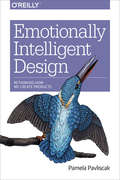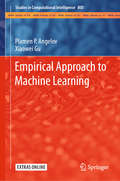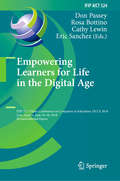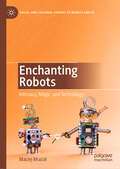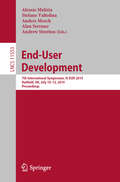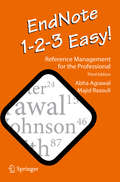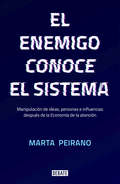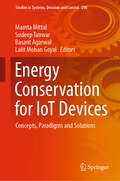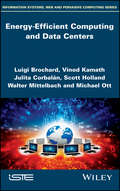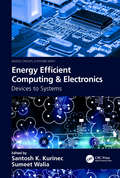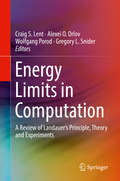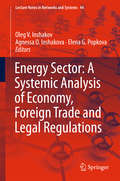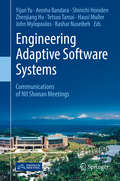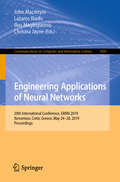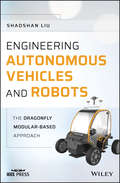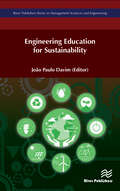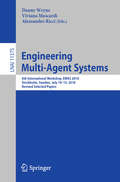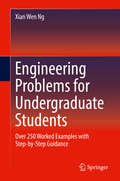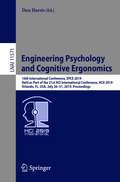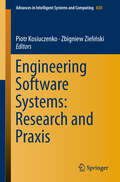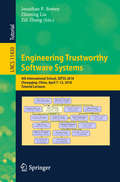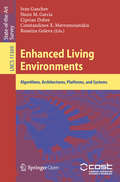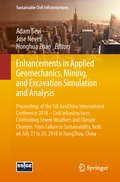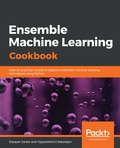- Table View
- List View
Emotionally Intelligent Design: Rethinking How We Create Products
by Pamela PavliscakAs technology becomes deeply integrated into every aspect of our lives, we’ve begun to expect more emotionally intelligent interactions. But smartphones don’t know if we’re having a bad day, and cars couldn’t care less about compassion. Technology is developing more IQ, but it still lacks EQ.In this book, Pamela Pavliscak—design researcher and advisor to Fortune 500 companies—explores new research about emotion, new technology that engages emotion, and new emotional design practices. Drawing on her own research and the latest thinking in psychology, neuroscience, and behavioral economics, Pamela shows you how design can help promote emotional well-being.You’ll learn:How design has transformed emotion and how tech is transforming it againNew principles for merging emotional intelligence and design thinkingHow to use a relationship model for framing product interactions and personalityMethods for blending well-being interventions with design patternsHow emotional resonance can guide designers toward ethical futuresImplications of emotionally intelligent technology as it scales from micro- to mega-emotional spheres
Empirical Approach to Machine Learning (Studies in Computational Intelligence #800)
by Plamen P. Angelov Xiaowei GuThis book provides a ‘one-stop source’ for all readers who are interested in a new, empirical approach to machine learning that, unlike traditional methods, successfully addresses the demands of today’s data-driven world. After an introduction to the fundamentals, the book discusses in depth anomaly detection, data partitioning and clustering, as well as classification and predictors. It describes classifiers of zero and first order, and the new, highly efficient and transparent deep rule-based classifiers, particularly highlighting their applications to image processing. Local optimality and stability conditions for the methods presented are formally derived and stated, while the software is also provided as supplemental, open-source material. The book will greatly benefit postgraduate students, researchers and practitioners dealing with advanced data processing, applied mathematicians, software developers of agent-oriented systems, and developers of embedded and real-time systems. It can also be used as a textbook for postgraduate coursework; for this purpose, a standalone set of lecture notes and corresponding lab session notes are available on the same website as the code.Dimitar Filev, Henry Ford Technical Fellow, Ford Motor Company, USA, and Member of the National Academy of Engineering, USA: “The book Empirical Approach to Machine Learning opens new horizons to automated and efficient data processing.”Paul J. Werbos, Inventor of the back-propagation method, USA: “I owe great thanks to Professor Plamen Angelov for making this important material available to the community just as I see great practical needs for it, in the new area of making real sense of high-speed data from the brain.” Chin-Teng Lin, Distinguished Professor at University of Technology Sydney, Australia: “This new book will set up a milestone for the modern intelligent systems.”Edward Tunstel, President of IEEE Systems, Man, Cybernetics Society, USA: “Empirical Approach to Machine Learning provides an insightful and visionary boost of progress in the evolution of computational learning capabilities yielding interpretable and transparent implementations.”
Empowering Learners for Life in the Digital Age: IFIP TC 3 Open Conference on Computers in Education, OCCE 2018, Linz, Austria, June 24–28, 2018, Revised Selected Papers (IFIP Advances in Information and Communication Technology #524)
by Don Passey Rosa Bottino Cathy Lewin Eric SanchezThis book constitutes the refereed post-conference proceedings of the IFIP TC 3 Open Conference on Computers in Education, OCCE 2018, held in Linz, Austria, in June 2018.The 24 revised full papers and 3 short papers included in this volume were carefully reviewed and selected from 63 submissions during two rounds of reviewing. The papers discuss key emerging topics and evolving practices in the area of educational computing research. They are organized in the following topical sections: computational thinking; programming and computer science education; teachers’ education and professional development; games-based learning and gamification; learning in specific and disciplinary contexts; learning in social networking environments; and self-assessment, e-assessment and e-examinations.
Enchanting Robots: Intimacy, Magic, and Technology (Social and Cultural Studies of Robots and AI)
by Maciej MusiałThis book argues that robots are enchanting humans (as potential intimate partners), because humans are enchanting robots (by performing magical thinking), and that these processes are a part of a significant re-enchantment of the “modern” world. As a foundation, the author examines arguments for and against intimate relationships with robots, particularly sex robots and care robots. Moreover, the book provides a consideration of human-robot interactions and philosophical reflections about robots through the lens of magic and magical thinking as well as theoretical and practical re-evaluations of their status and presence. Furthermore, the author discusses the abovementioned issues in the context of disenchantment and re-enchantment of the world, characterizing modernity as a coexistence of these two processes. The book closes with a consideration of future scenarios regarding the meaning of life in the age of rampant automation and the possibility that designing robots becomes a sort of new eugenics as a consequence of recognizing robots as persons.
The End of Forgetting: Growing Up with Social Media
by Kate EichhornThanks to Facebook and Instagram, our younger selves have been captured and preserved online. But what happens, Kate Eichhorn asks, when we can’t leave our most embarrassing moments behind? Rather than a childhood cut short by a loss of innocence, the real crisis of the digital age may be the specter of a childhood that can never be forgotten.
End-User Development: 7th International Symposium, IS-EUD 2019, Hatfield, UK, July 10–12, 2019, Proceedings (Lecture Notes in Computer Science #11553)
by Alessio Malizia Stefano Valtolina Anders Morch Alan Serrano Andrew StrattonThis book constitutes the refereed proceedings of the 7th International Symposium on End-User Development, IS-EUD 2017, held in Hatfield, UK, in July 2019. The 9 full papers and 8 short papers presented were carefully reviewed and selected from 35 submissions. The papers discuss progress in research around end-user development through, or towards, methods, socio-technical environments, intelligent agents, as well as the most effective end-user programming paradigms for smart environments. Papers and submissions in all categories addressed this specific theme together with topics that have been traditionally covered by the broader themes of end-user development, such as domain specific tools, spreadsheets, educational applications, and end user aspects.
EndNote 1-2-3 Easy!: Reference Management for the Professional
by Abha Agrawal Majid RasouliThis book is intended for healthcare professionals, biomedical researchers, health policy experts, and graduate students who frequently write and publish scientific manuscripts in peer reviewed journals. This new edition updates earlier versions with an emphasis on the most currently available Clarivate Analytics software application EndNote X9, a widely used reference management software. For first-time users of EndNote X9, this book is a comprehensive and well-illustrated instruction manual for getting started, including detailed instructions on installation, creating reference libraries, and ultimately creating complete and accurate citation-based bibliographies necessary to achieve successful peer reviewed publications. There is also a full chapter devoted to careful guidance for the growing practice of citing references from online internet sources. For existing “power users” of current and earlier versions of EndNote, this book provides quick and easy access to a comprehensive compendium of nuanced and advanced features of this powerful software, with an emphasis on providing greater ease and control in coordinating and curating research materials and bibliographies with research collaborators and scientific writing teams. The authors have also added new, state-of-the-art “how-to” guidance on a variety of methods of using EndNote, including PubMed, Google Scholar, Web of Science, Scopus and others. Like many legacy software systems, Clarivate Analytics has also begun to offer an online “desktop” version of EndNote, a topic which is now also covered in Chapter 10 (EndNote Online) of this new edition.
El enemigo conoce el sistema: Manipulación de ideas, personas e influencias después de la economía de la atención
by Marta PeiranoTodo lo que no quieres pero necesitas saber sobre el poder, la economía, la sociedad y las telecomunicaciones en la era de la información. La red no es libre, ni abierta ni democrática. Es un conjunto de servidores, conmutadores, satélites, antenas, routers y cables de fibra óptica controlados por un número cada vez más pequeño de empresas. Es un lenguaje y una burocracia de protocolos que hacen que las máquinas hablen, normas de circulación que conducen el tráfico, microdecisiones que definen su eficiencia. Si la consideramos un único proyecto llamado internet, podemos decir que es la infraestructura más grande jamás construida, y el sistema que define todos los aspectos de nuestra sociedad. Y sin embargo es secreta. Su tecnología está oculta, enterrada, sumergida o camuflada; sus algoritmos son opacos; sus microdecisiones son irrastreables. Los centros de datos que almacenan y procesan la información están ocultos y protegidos por armas, criptografía, propiedad intelectual y alambre de espino. La infraestructura crítica de nuestro tiempo está fuera de nuestra vista. No podemos comprender la lógica, la intención y el objetivo de lo que no vemos. Todas las conversaciones que tenemos sobre esa infraestructura son en realidad conversaciones sobre su interfaz, un conjunto de metáforas que se interpone entre nosotros y el sistema. Un lenguaje diseñado, no para facilitar nuestra comprensión de esa infraestructura, sino para ofuscarla. El enemigo conoce el sistema pero nosotros no. Este libro te ayudará a conocerlo, y a comprender por qué la herramienta más democratizadora de la historia se ha convertido en una máquina de vigilancia y manipulación de masas al servicio de regímenes autoritarios. Solo así podremos convertirla en lo que más falta nos hace: una herramienta para gestionar la crisis que se avecina de la manera más humana posible. No tenemos un segundo que perder.
Energy Conservation for IoT Devices: Concepts, Paradigms and Solutions (Studies in Systems, Decision and Control #206)
by Mamta Mittal Sudeep Tanwar Basant Agarwal Lalit Mohan GoyalThis book addresses the Internet of Things (IoT), an essential topic in the technology industry, policy, and engineering circles, and one that has become headline news in both the specialty press and the popular media. The book focuses on energy efficiency concerns in IoT and the requirements related to Industry 4.0. It is the first-ever “how-to” guide on frequently overlooked practical, methodological, and moral questions in any nations’ journey to reducing energy consumption in IoT devices. The book discusses several examples of energy-efficient IoT, ranging from simple devices like indoor temperature sensors, to more complex sensors (e.g. electrical power measuring devices), actuators (e.g. HVAC room controllers, motors) and devices (e.g. industrial circuit-breakers, PLC for home, building or industrial automation). It provides a detailed approach to conserving energy in IoT devices, and comparative case studies on performance evaluation metrics, state-of-the-art approaches, and IoT legislation.
Energy-Efficient Computing and Data Centers: Energy Efficient Computing And Data Centers
by Luigi Brochard Vinod Kamath Julita Corbalán Scott Holland Walter Mittelbach Michael OttData centers consume roughly 1% of the total electricity demand, while ICT as a whole consumes around 10%. Demand is growing exponentially and, left unchecked, will grow to an estimated increase of 20% or more by 2030. This book covers the energy consumption and minimization of the different data center components when running real workloads, taking into account the types of instructions executed by the servers. It presents the different air- and liquid-cooled technologies for servers and data centers with some real examples, including waste heat reuse through adsorption chillers, as well as the hardware and software used to measure, model and control energy. It computes and compares the Power Usage Effectiveness and the Total Cost of Ownership of new and existing data centers with different cooling designs, including free cooling and waste heat reuse leading to the Energy Reuse Effectiveness. The book concludes by demonstrating how a well-designed data center reusing waste heat to produce chilled water can reduce energy consumption by roughly 50%, and how renewable energy can be used to create net-zero energy data centers.
Energy Efficient Computing & Electronics: Devices to Systems (Devices, Circuits, and Systems)
by Krzysztof Iniewski, Santosh K. Kurinec and Sumeet WaliaIn our abundant computing infrastructure, performance improvements across most all application spaces are now severely limited by the energy dissipation involved in processing, storing, and moving data. The exponential increase in the volume of data to be handled by our computational infrastructure is driven in large part by unstructured data from countless sources. This book explores revolutionary device concepts, associated circuits, and architectures that will greatly extend the practical engineering limits of energy-efficient computation from device to circuit to system level. With chapters written by international experts in their corresponding field, the text investigates new approaches to lower energy requirements in computing. Features • Has a comprehensive coverage of various technologies • Written by international experts in their corresponding field • Covers revolutionary concepts at the device, circuit, and system levels
Energy Limits in Computation: A Review of Landauer’s Principle, Theory and Experiments
by Craig S. Lent Alexei O. Orlov Wolfgang Porod Gregory L. SniderThis book is a single-source reference to the issues involved in the Landauer principle, which has gained new prominence recently, due to the large amount of heat generated by today’s computers. If Landauer’s principle is correct, there may be ways to build computers that dissipate far less power (corresponding to heat generated) than today’s computers. This book brings together all sides of the discussions regarding Landauer’s principle, both theoretical and experimental, empowering readers to gain better understanding of dissipation in computation, and the limits if any to progress in computation related to energy dissipation. It represents the best and most thorough examination of the important issue of Landauer’s principle that is available in one volume.Provides an in-depth investigation of the Landauer principle and how it relates to the possible existence of lower bounds on dissipation in computation;Gathers together both sides of the discussion: those who agree with Landauer and his conclusions, and those who think that Landauer was not correct, offering fresh perspective on the issues in the new light of experiments;Offers insight into the future of silicon CMOS and the limits if any to progress in computation related to energy dissipation.
Energy Sector: A Systemic Analysis of Economy, Foreign Trade and Legal Regulations (Lecture Notes in Networks and Systems #44)
by Elena G. Popkova Agnessa O. Inshakova Oleg V. InshakovThis book is a comprehensive economic and legal study of the theoretical and practical aspects of the problems of increasing energy efficiency; self-motivation of energy saving by business entities within the framework of their corporate responsibility; regulatory mechanisms to stimulate energy conservation in the economy; civil-law regulation of foreign trade turnover of energy resources between economic entities of the Russian Federation and companies of member states of international integration associations – the CIS, EEMP, the EU and BRICS. It argues that technological energy saving plays a key role in reducing the energy intensity and increasing the energy efficiency of the economy, and substantiates the need for institutional support – including legal support for the participation of the Russian Federation – in various forms of international cooperation. Lastly, based on an analysis of current legislation, programs and recommendations, judicial and contractual practices, customs and trade procedures, it offers proposals for the developing, improving and unifying civil law regulation of obligations in the sphere of international trade in energy resources, as well as methodological recommendations for drafting foreign trade contracts in the energy sector.
Engineering Adaptive Software Systems: Communications Of NII Shonan Meetings (Lecture Notes In Computer Science / Programming And Software Engineering Ser. #7475)
by Yijun Yu Arosha Bandara Shinichi Honiden Zhenjiang Hu Tetsuo Tamai Hausi Muller John Mylopoulos Bashar NuseibehThis book discusses the problems and challenges in the interdisciplinary research field of self-adaptive software systems. Modern society is increasingly filled with software-intensive systems, which are required to operate in more and more dynamic and uncertain environments. These systems must monitor and control their environment while adapting to meet the requirements at runtime. This book provides promising approaches and research methods in software engineering, system engineering, and related fields to address the challenges in engineering the next-generation adaptive software systems. The contents of the book range from design and engineering principles (Chap. 1) to control–theoretic solutions (Chap. 2) and bidirectional transformations (Chap. 3), which can be seen as promising ways to implement the functional requirements of self-adaptive systems. Important quality requirements are also dealt with by these approaches: parallel adaptation for performance (Chap. 4), self-adaptive authorization infrastructure for security (Chap. 5), and self-adaptive risk assessment for self-protection (Chap. 6). Finally, Chap. 7 provides a concrete self-adaptive robotics operating system as a testbed for self-adaptive systems. The book grew out of a series of the Shonan Meetings on this ambitious topic held in 2012, 2013, and 2015. The authors were active participants in the meetings and have brought in interesting points of view. After several years of reflection, they now have been able to crystalize the ideas contained herein and collaboratively pave the way for solving some aspects of the research problems. As a result, the book stands as a milestone to initiate further progress in this promising interdisciplinary research field.
Engineering Applications of Neural Networks: 20th International Conference, EANN 2019, Xersonisos, Crete, Greece, May 24-26, 2019, Proceedings (Communications in Computer and Information Science #1000)
by Chrisina Jayne Lazaros Iliadis Ilias Maglogiannis John MacintyreThis book constitutes the refereed proceedings of the 19th International Conference on Engineering Applications of Neural Networks, EANN 2019, held in Xersonisos, Crete, Greece, in May 2019.The 35 revised full papers and 5 revised short papers presented were carefully reviewed and selected from 72 submissions. The papers are organized in topical sections on AI in energy management - industrial applications; biomedical - bioinformatics modeling; classification - learning; deep learning; deep learning - convolutional ANN; fuzzy - vulnerability - navigation modeling; machine learning modeling - optimization; ML - DL financial modeling; security - anomaly detection; 1st PEINT workshop.
Engineering Autonomous Vehicles and Robots: The DragonFly Modular-based Approach (Wiley - IEEE)
by Shaoshan LiuOffers a step-by-step guide to building autonomous vehicles and robots, with source code and accompanying videos The first book of its kind on the detailed steps for creating an autonomous vehicle or robot, this book provides an overview of the technology and introduction of the key elements involved in developing autonomous vehicles, and offers an excellent introduction to the basics for someone new to the topic of autonomous vehicles and the innovative, modular-based engineering approach called DragonFly. Engineering Autonomous Vehicles and Robots: The DragonFly Modular-based Approach covers everything that technical professionals need to know about: CAN bus, chassis, sonars, radars, GNSS, computer vision, localization, perception, motion planning, and more. Particularly, it covers Computer Vision for active perception and localization, as well as mapping and motion planning. The book offers several case studies on the building of an autonomous passenger pod, bus, and vending robot. It features a large amount of supplementary material, including the standard protocol and sample codes for chassis, sonar, and radar. GPSD protocol/NMEA protocol and GPS deployment methods are also provided. Most importantly, readers will learn the philosophy behind the DragonFly modular-based design approach, which empowers readers to design and build their own autonomous vehicles and robots with flexibility and affordability. Offers progressive guidance on building autonomous vehicles and robots Provides detailed steps and codes to create an autonomous machine, at affordable cost, and with a modular approach Written by one of the pioneers in the field building autonomous vehicles Includes case studies, source code, and state-of-the art research results Accompanied by a website with supplementary material, including sample code for chassis/sonar/radar; GPS deployment methods; Vision Calibration methods Engineering Autonomous Vehicles and Robots is an excellent book for students, researchers, and practitioners in the field of autonomous vehicles and robots.
Engineering Education for Sustainability
by João Paulo DavimUnderstood to be a key issue in modern society, sustainability is characterized by its three essential pillars, namely: the environment, society and the economy. Education plays an important role in how people understand and accept sustainability. The integration of sustainability in engineering education is a relatively new phenomenon, and presenting information about engineering education for sustainability is of great interest to improve communication between professors, researchers and students at universities, institutes and research laboratories.Topics discussed in the book include: Experiences from 5 years of educating sustainability to computer science students Review of decision support methods in green and sustainable supply chains Analyzing the drivers of engineering education for sustainability using the MCDM approach Visualization technologies in construction education: a comprehensive review of recent advances A legal framework and compliance with construction safety laws and regulations
Engineering Multi-Agent Systems: 6th International Workshop, EMAS 2018, Stockholm, Sweden, July 14-15, 2018, Revised Selected Papers (Lecture Notes in Computer Science #11375)
by Danny Weyns Viviana Mascardi Alessandro RicciThis book constitutes the revised and selected papers from the 6th International Workshop on Engineering Multi-Agent Systems held in Stockholm, Sweden, in July 2018, in conjunction with AAMAS 2018. The 17 full papers presented in this volume were carefully reviewed and selected from 32 submissions. The book also contains a state-of-the-art paper that reflects on the role and potential of MAS engineering in a number of key facets. The papers are clustered around the following themes: programming agents and MAS, agent-oriented software engineering, formal analysis techniques, rational agents, modeling and simulation, frameworks and application domains.
Engineering Problems for Undergraduate Students: Over 250 Worked Examples with Step-by-Step Guidance
by Xian Wen NgThis textbook supplement deconstructs some of the most commonly-encountered and challenging problems arising within engineering domains such as thermodynamics, separation processes, chemical kinetics, fluid dynamics, and engineering mathematics that are foundational to most engineering programs, as well as many courses in STEM disciplines. The book is organized into a series of 250 problems and worked solutions, with problems written in a format typical of exam questions. The book provides students ample practice in solving problems and sharpening their skill applying abstract theoretical concepts to solving exam problems. The presentation of detailed step-by-step explanations for each problem from start to finish in this book helps students follow the train of thought toward arriving at the final numerical solutions to the problems.Stands as an all-in-one, multidisciplinary, engineering problem-solving resource with comprehensive depth and breadth of coverage;Adopts a highly relevant question and answer pedagogy;Maximizes understanding through clear use of visuals;Emphasizes detailed, step-by-step explanations;Includes supplementary sections of cross-referenced concepts.
Engineering Psychology and Cognitive Ergonomics: 16th International Conference, EPCE 2019, Held as Part of the 21st HCI International Conference, HCII 2019, Orlando, FL, USA, July 26–31, 2019, Proceedings (Lecture Notes in Computer Science #11571)
by Don HarrisThis book constitutes the proceedings of the 16th International Conference on Engineering Psychology and Cognitive Ergonomics, EPCE 2019, held as part of the 21st International Conference, HCI International 2019, which took place in Orlando, FL, USA, in July 2019.The total of 1274 papers and 209 posters included in the 35 HCII 2019 proceedings volumes was carefully reviewed and selected from 5029 submissions.EPCE 2019 includes a total of 34 regular papers; they were organized in topical sections named: mental workload and performance; visual cognition; cognitive psychology in aviation and space; and group collaboration and decision making.
Engineering Software Systems: Research and Praxis (Advances In Intelligent Systems and Computing #830)
by Zbigniew Zieliński Piotr KosiuczenkoThis book highlights a range of new approaches and concepts in the field of software engineering. Based on systematic methods, graphical and formal models, the approaches are designed for solving practical problems encountered in actual software development. The book is divided into 13 chapters, which address core aspects such as security, performance and quality measurement. Chiefly intended to stimulate new research by presenting real problems faced by the industry, and to facilitate software development by applying precisely defined, validated and efficient models and methods, the book offers a valuable guide – for researchers and industry practitioners at small, medium and large companies alike.
Engineering Trustworthy Software Systems: 4th International School, SETSS 2018, Chongqing, China, April 7–12, 2018, Tutorial Lectures (Lecture Notes in Computer Science #11430)
by Jonathan P. Bowen Zhiming Liu Zili ZhangThis volume contains lectures on leading-edge research in methods and tools for use in computer system engineering; at the 4th International School on Engineering Trustworthy Software Systems, SETSS 2018, held in April 2018 at Southwest University in Chongqing, China.The five chapters in this volume provide an overview of research in the frontier of theories, methods, and tools for software modelling, design, and verification. The topics covered in these chapter include Software Verification with Whiley, Learning Büchi Automata and Its Applications, Security in IoT Applications, Programming in Z3, and The Impact of Alan Turing: Formal Methods and Beyond. The volume provides a useful resource for postgraduate students, researchers, academics, and engineers in industry, who are interested in theory, methods, and tools for the development of trustworthy software.
Enhanced Living Environments: Algorithms, Architectures, Platforms, and Systems (Lecture Notes in Computer Science #11369)
by Rossitza Goleva Constandinos X. Mavromoustakis Ciprian Dobre Nuno M. Garcia Ivan GanchevThis open access book was prepared as a Final Publication of the COST Action IC1303 “Algorithms, Architectures and Platforms for Enhanced Living Environments (AAPELE)”. The concept of Enhanced Living Environments (ELE) refers to the area of Ambient Assisted Living (AAL) that is more related with Information and Communication Technologies (ICT). Effective ELE solutions require appropriate ICT algorithms, architectures, platforms, and systems, having in view the advance of science and technology in this area and the development of new and innovative solutions that can provide improvements in the quality of life for people in their homes and can reduce the financial burden on the budgets of the healthcare providers.The aim of this book is to become a state-of-the-art reference, discussing progress made, as well as prompting future directions on theories, practices, standards, and strategies related to the ELE area. The book contains 12 chapters and can serve as a valuable reference for undergraduate students, post-graduate students, educators, faculty members, researchers, engineers, medical doctors, healthcare organizations, insurance companies, and research strategists working in this area.
Enhancements in Applied Geomechanics, Mining, and Excavation Simulation and Analysis: Proceedings of the 5th GeoChina International Conference 2018 – Civil Infrastructures Confronting Severe Weathers and Climate Changes: From Failure to Sustainability, held on July 23 to 25, 2018 in HangZhou, China (Sustainable Civil Infrastructures)
by Adam Sevi Jose Neves Honghua ZhaoThe book presents a compilation of studies regarding applied geomechanics, mining, and excavation analysis and simulation. The material is suitable for presentation to senior undergraduate and post-graduate students in both mining and geological engineering. It should also be of interest to students of other aspects of Geomechanics and, notably, engineering geologists interested in mining and underground excavation design. Practising mining engineers and rock mechanics engineers involved in mine design may use the book profitably to obtain an appreciation of the current state of engineering knowledge in their area of specialisation. Papers were selected from the 5th GeoChina International Conference on Civil Infrastructures Confronting Severe Weathers and Climate Changes: From Failure to Sustainability, held in July 23-25, 2018 in Hang Zhou, China.
Ensemble Machine Learning Cookbook: Over 35 practical recipes to explore ensemble machine learning techniques using Python
by Dipayan Sarkar Vijayalakshmi NatarajanThis book is for data scientists, machine learning developers, and deep learning enthusiasts who want to deep dive into machine learning algorithms to build powerful ensemble models. Working knowledge of Python programming and basic statistics is expected.
